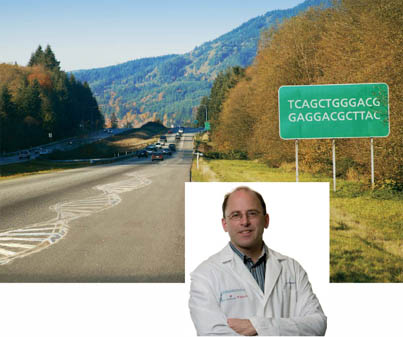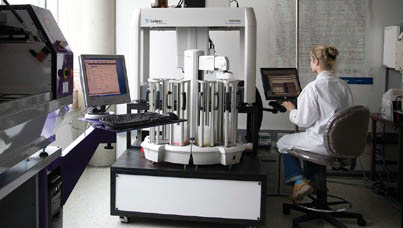By Mark Reynolds
McGill professor was cornerstone of international research effort to compare genomes around the globe

Like creeping ivy, a pair of sinuous DNA strands ascend a cement structural support pole that interrupts the view of the slopes of Mount Royal from Tom Hudson’s office windows. It is art with particular relevance to the life and work of the director of the McGill University and Génome Québec Innovation Centre.
Hudson received the painting as a gift from Jacques DesHaies, an artist who illustrates covers for the prestigious science journal Nature, which, in the fall of 2005, prominently featured Hudson’s contributions to one of the largest international scientific accomplishments of the last decade. Part of a network of hundreds of scientists from a half-dozen countries, Hudson and his colleagues in Montreal were instrumental in completing the comparative map of the human genome—called HapMap (for haplotype map)—that will allow scientists to identify genetic variants that cause disease.
When the sequencing of the human genome was completed to great fanfare in 2001, it was hailed as one of the greatest advances in our understanding of how DNA works. But it was a limited tool—the sequence was based on the code of a single individual. The next step would be to catalogue the genomes of enough individuals that comparisons could be made across the whole genome. This information would allow researchers to have a de facto “normal” genome as a model to compare with the DNA of individuals.
“So how could we look at the whole human genome from the sequence of one person? We had to create tools to scan genomes to find mutations,” explains Hudson, who also played a key role in the Human Genome Project during his time at the Whitehead Institute for Biomedical Research, which is affiliated with the Massachusetts Institute of Technology. With three billion base pairs, this would be a daunting task unless some method were found to break the genome down into smaller, yet still meaningful chunks.
The breakthrough that led to HapMap came in 2001, when Hudson and his colleagues at MIT discovered that genes linked to inflammatory bowel disease tended to mutate in predictable groups clustered together in regions. Called haplotypes, these groups of linked variants are like bar codes that correspond to certain complex genetic characteristics. For geneticists, these groupings of genes can reduce the puzzle of genetic disease from billions of pieces to “only” 100,000 or so. Locating these bar codes was the goal of the HapMap project.
Even with the task relatively simplified in this way, the project was enormous and required contributions from an army of scientists, statisticians, ethicists and community outreach workers from China, Japan, Canada, the United States and the United Kingdom. Together, those countries contributed $180 million to see the project through. DNA was collected from donors in Africa, Asia and North America to ensure geographic diversity, and the greatest care was taken to guarantee informed consent and anonymity.
“When there’s enthusiasm for an idea, it crosses the globe very quickly. It certainly was seen to be a feasible project with, potentially, a huge impact, and a good investment for the community,” says Hudson, whose contributions to HapMap were funded by Genome Canada and Génome Québec. When the project was conceived in 2002, desire to participate was widespread. In the end, only those scientists with the greatest ability to contribute to the massive undertaking were selected. With his established record in the field and the best equipment at his disposal, Hudson and the Innovation Centre at McGill were natural choices.
“Research has gone global, and alliances are formed between groups who complement each other well in terms of expertise. All the expertise for a project like this doesn’t exist at McGill, it doesn’t exist in Boston. And it’s expensive—even the US, which has a lot of money, wouldn’t be able to fund something like this. We were able to create a mesh of labs with complementary abilities,” says Hudson.

The eventual goal of the HapMap project is to identify genetic bar codes so as to be able to characterize and potentially devise treatments for disease, work that has already begun. In addition to its utility as an analytic tool, HapMap has provided insights into the human genome on its own.
Hudson says that it was already fairly well understood that most individuals are 99 per cent identical, genetically speaking. HapMap shows that genetic variations from individual to individual, and population to population, also tend to be similar. In other words, a haplotype bar code that corresponds to curly hair will be the same whether the person was born in Beijing or Brandon, Manitoba. “It actually redefines what genome variation looks like in world populations. In fact, most variations you’ll find in Toronto, you’ll find in Africa, and most variations you’d find in Asia, you’d find in South America.”
Hudson says this finding has some exciting implications for science. “If most haplotypes are the same across populations, then it will be the same with mutations. The things that cause asthma in North America are most likely the same things that cause asthma in Asia.”
The kind of genetic screening that the HapMap project allows can dramatically improve the survival rates for diseases such as colon cancer, for instance, where there is a 90 per cent chance of a cure if tumours are caught early. But for many people, genetic screening raises fears as to how the results will be used. Genetic screening could be used to discriminate against individuals for employment or insurance, for example. While there is a five-year moratorium in the US barring such practices, the laws in Canada are less stringent, which Hudson says has to change.
In some ways, the HapMap is already being misused—or at least misrepresented—by organizations with their own agenda. “My colleagues have been quoted in articles that are trying to justify racism. Hate groups do exist in this world, and I didn’t realize that before I saw some of these websites,” says Hudson.
“There is no such thing as race—there’s no boundary in genomics to show that one population is different from another,” he emphasizes. If anything, the HapMap results go a long way to dispelling myths about human populations, proving that our differences are even less than theorized. The research shows that, genetically, humankind is one big family.
For more information on Tom Hudson and HapMap please see the McGill Reporter: www.mcgill.ca/reporter/38/06/hudson/
Drawing the HapMap

Opened in 2002, the McGill University and Génome Québec Innovation Centre, a concrete and glass monument to modern science on Montreal’s Dr. Penfield Avenue, has established itself as one of the best in the world.
Tom Hudson and his colleagues at the Centre were an obvious choice to take a leading role in the international HapMap project. The Centre has roughly 120 primary investigators associated with it, drawn from McGill faculty. In its brief existence, it has become the go-to facility in Canada for genotyping work.
The numbers are mind-boggling—more than 260 labs from across the country have used the Centre’s expertise in genotyping, sequencing, DNA and proteomics. Additional work with the Montreal Heart Institute in pharmacogenetics aims to bring genomic and proteomic developments to clinical practice.
Last year, Hudson says the Centre performed more than one billion genomics tests, worth over $12 million. Much of this revenue is invested directly into new equipment, so the Centre remains at the forefront of technology in the field. Hudson proudly asserts that it is a model for similar institutions in other countries.
When HapMap came calling, Hudson was ready. Hudson’s portion of the project required mapping haplotypes on roughly 10 per cent of the genome. The huge job went much faster because of the Illumina technique used at McGill, the most up-to-date technology in the field. Using this technique, DNA segments are tagged with synthetic markers that will bind to known portions of the DNA molecule, branding each with a particular colour. Pencil-thin devices, each containing 50,000 fibre optic filaments, can then light up these segments and isolate them. Hudson’s lab would do 1,500 tests of 25 identical segments at a time—the duplication necessary for statistical accuracy.
The HapMap goal was to be able to map out the genome to every 5,000 base pairs. That 1:5,000 degree of accuracy compares well to topographical maps, the best of which use a scale of 1:25,000. By early 2005 they had already improved on that, mapping to every 3,000, which brought the research to the end of Phase I. Those results were released in late 2005 in one of the largest articles that the prestigious journal Nature has ever published. Once the HapMap data were in, researchers at McGill were among the first to use the powerful new tool.
“We did wait for the end of HapMap to start analyzing data. Colon cancer, adult diabetes and multiple sclerosis were our three largest projects last year,” says Hudson. McGill professors are revealing the mechanisms of contagious disease using HapMap—genes linked to susceptibility to leprosy have now been identified by the research of Erwin Schurr, from the McGill Centre for the Study of Host Resistance.
